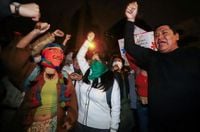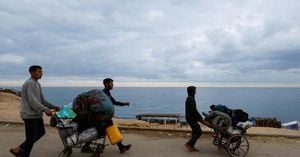Political turmoil has once again swept through Peru, as President Dina Boluarte was ousted by Congress on October 10, 2025, marking yet another chapter in the South American nation’s ongoing saga of instability. The move came amid escalating violent crime, widespread public dissatisfaction, and mounting corruption probes, culminating in a near-unanimous vote to remove her from office. With the 38-year-old head of Congress, José Jerí, now sworn in as interim president, Peru faces a period of uncertainty as it awaits elections scheduled for April 2026.
Boluarte’s removal was as swift as it was decisive. According to The Associated Press, 124 of the 130-member unicameral Congress voted just past midnight to impeach her, with no votes against the effort. The grounds? Lawmakers cited her government’s inability to stem crime, a charge that resonated strongly after a shooting at a popular concert in Lima left five people injured just days before the vote. The violence only deepened public anger over a crime wave that has gripped the country for months.
In a televised address following her ouster, Boluarte sought to defend her record, stating, “I have not thought of myself, but rather of Peruvians.” Yet, even as she spoke, the broadcast was abruptly interrupted to show Jerí being sworn in as the new president—a symbolic moment underscoring the end of her tumultuous term.
Boluarte’s presidency, which began in December 2022 after the impeachment of her predecessor Pedro Castillo, was marked by relentless controversy. She had served as Castillo’s vice president and assumed office to complete his term after he was removed for attempting to dissolve the legislature to avoid his own ouster. Her time in office was quickly consumed by scandal, protests, and a wave of violent crime. In fact, there were more than 500 protests demanding her resignation in just the first three months of her presidency, according to The Associated Press.
One of the most contentious moments of her tenure came in July 2025, when Boluarte decided to double her salary—making it thirty-five times the minimum wage—at a time when the country’s economy was struggling and crime rates were soaring. As reported by James Blears, this move further eroded her already dismal approval rating, which had plummeted to below five percent. The public’s frustration was palpable, and the political writing was on the wall.
Peru’s challenges extend far beyond the presidency. The nation has seen an extraordinary turnover in leadership, with seven presidents in the past nine years—three of whom were removed by Congress and three currently in prison. The normal presidential term is five years, but recent history has made such stability seem almost unattainable. Boluarte herself was the sixth leader since 2018, a testament to the country’s ongoing struggle with political volatility.
The immediate catalyst for Boluarte’s removal was the government’s inability to contain a rising tide of violent crime. Official figures revealed that 6,041 people were killed between January and mid-August 2025, the highest number for that period since 2017. Extortion complaints soared to 15,989 between January and July—a 28% increase compared to the same period in 2024. The shooting at the Agua Marina concert in Lima, which left five injured, was just the latest in a series of violent incidents that underscored the government’s failure to ensure public safety.
Boluarte, for her part, partially blamed the surge in crime on illegal immigration. During a military ceremony on October 8, she declared, “This crime has been brewing for decades and has been strengthened by illegal immigration, which past administrations haven’t defeated. Instead, they’ve opened the doors of our borders and allowed criminals to enter everywhere... without any restrictions.” Her comments, however, did little to quell public anger or shift the blame away from her administration’s perceived shortcomings.
Prime Minister Eduardo Arana attempted a last-ditch defense of Boluarte during a crime-focused parliamentary hearing on October 9, arguing, “Parliament’s concerns are not resolved by addressing a request for impeachment, much less by approving it. We are not clinging to our positions. We are here, and we knew from the beginning that our first day here could also be our last day in office.” But the overwhelming consensus among lawmakers left little room for debate.
After the impeachment vote, speculation swirled about Boluarte’s next move, with some media reports suggesting she might seek asylum abroad. But she quickly quashed those rumors, standing outside her Lima home to address reporters. “Media reports said... that I was looking to get asylum. None of that is true,” she asserted. “Those cases that are under investigation... I am not responsible for any of them. I am calm, I am at home, and I will remain in the country permanently.” Prosecutors have demanded that Boluarte be prevented from leaving Peru while she is investigated on charges including money laundering and misuse of office.
For now, the reins of power have passed to José Jerí, who has promised to defend Peru’s sovereignty and hand over authority to the winner of the April 2026 election. Jerí, a 38-year-old lawyer and president of Congress, faces the daunting task of restoring stability in a country weary of political upheaval. As he steps into the role, he inherits not only a nation gripped by crime and economic hardship but also a deeply fractured political landscape.
The broader context is sobering. Peru’s cycle of impeachments and interim governments has created an atmosphere of uncertainty, making it difficult for any administration to enact lasting reforms or address the root causes of the country’s challenges. The removal of Boluarte, following so closely on the heels of her predecessor’s downfall, only reinforces the sense that Peru’s political crisis is far from over.
With elections on the horizon and investigations into Boluarte’s conduct ongoing, Peruvians find themselves once again at a crossroads. The coming months will test not only the resolve of the interim government but also the resilience of the nation’s democratic institutions. As the country braces for yet another transition, the hope is that a new leader might finally bring the stability and security that has so long eluded Peru.




